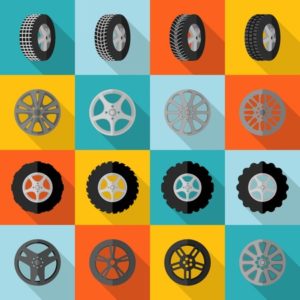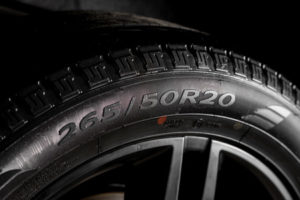If you’re not a fan of the wheels already on your car, the first step towards replacement is to figure out what fits. But if you’re like most people, the first step you take is to ogle wheels online and decide what looks good, then worry about if your choice will fit. Knowing about wheel sizes for cars will help save you a lot of time and hassle.
Take some of the anxiety out of the wheel shopping experience by learning how to select the appropriate wheels. You’ll avoid getting attached to something that won’t work, and it’ll make choosing wheels easier because the options will be narrowed down from the beginning.
Measuring Wheel Sizes for Cars
Before you begin, you need to understand wheel sizes for cars. Each wheel is measured in a few different ways.
 First off is the diameter, or the distance from one edge of the wheel across the face or front, to the opposite edge.
First off is the diameter, or the distance from one edge of the wheel across the face or front, to the opposite edge.- Next is width, or the distance from bead seat to bead seat on the barrel of the wheel. This is where the tire sits, or is the part you can’t see with the tire mounted.
- Wheel size also includes the wheel bolt pattern, which includes two numbers. The first is the number of bolt holes in the wheel. The second number is the distance from one hole to another, going across the face or middle of the wheel, in millimeters.
- Finally, there’s offset. This is the distance in millimeters between the mounting surface and centerline of the wheel.
Many people wonder how they can measure car wheel sizes. You can measure everything but wheel width with the tire mounted. It’s a straightforward process with a tape measure. These measurements are critical, since they must be compatible with your vehicle, or it might not fit and could pose a safety issue.
Other Wheel Size Considerations
If you want to change the wheel size on a car, there’s more to the process. The wheels need to be small enough to clear everything else on the car, including suspension components, the fenders and other components.
If your vehicle is stock, there are plenty of guides that will tell you how much bigger you can go with the diameter and even the width. If you’ve installed a lift or lowering kit, the kit’s manufacturer should supply this info.
Don’t Forget Tire Size
While you’re looking at wheel sizes for cars, you’ll also need to figure out what size tires will fit on your car. Tire size is dictated partly by the wheels you get, because the tires must be wide enough to fit. If you’ve upgraded your wheel size, you need to choose tires that will clear the fenders and suspension components, otherwise you’ll have rubbing, which wears down the tread unevenly.
Tires have their sizing information printed right on the sidewall. Here’s how to interpret the numbers and letters you see.
 The first letter indicates the use of the tire (P for passenger car, LT for light truck, etc.). Some tires may not include this number.
The first letter indicates the use of the tire (P for passenger car, LT for light truck, etc.). Some tires may not include this number.- The second number is the section width, or the overall width of the tire, in millimeters.
- The number after the forward slash is the aspect ratio, or the distance from the wheel mounting surface to the outside of the tread. Essentially, it shows how tall the tire is.
- Then there’s a letter for the speed rating, followed by a letter indicating construction type.
- The last number is the size, or diameter, which needs to match up with the wheel.
Ultimately, some people question if tire size really matters. It does, because it affects performance. Aside from fitting on the vehicle without rubbing, the height of the sidewall is key. Taller sidewalls absorb the forces from impacts, like hitting a pothole, better than low profile tires, or tires with short sidewalls. When it comes to cornering hard, the taller sidewalls provide a mushier feeling, while the shorter ones add a crisp feeling to how the car handles.
If this process still seems confusing, the best thing to do is consult with a professional. They can walk you through everything, and help ensure you don’t compromise performance and safety for looks.










Leave a Reply
You must be logged in to post a comment.